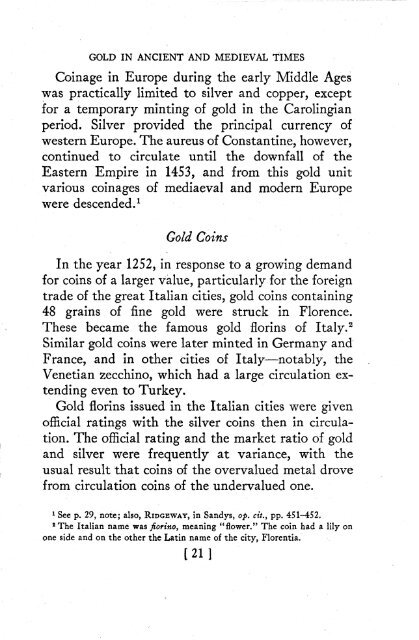You also want an ePaper? Increase the reach of your titles
YUMPU automatically turns print PDFs into web optimized ePapers that Google loves.
GOLD IN ANCIENT AND MEDIEVAL TIMES<br />
Coinage in Europe during <strong>the</strong> early Middle Ages<br />
was practically limited to silver <strong>and</strong> copper, except<br />
for a temporary minting of gold ·in· <strong>the</strong> Carolingian<br />
period. Silver provided <strong>the</strong> principal currency of<br />
western Europe. The aureus of Constantine, however,<br />
continued to circulate until <strong>the</strong> downfall of <strong>the</strong><br />
Eastern Empire in 1453, <strong>and</strong> from this gold unit<br />
various coinages of mediaeval <strong>and</strong> modern Europe<br />
were descended. 1<br />
<strong>Gold</strong> Coins<br />
In <strong>the</strong> year 1252, in response to a growing dem<strong>and</strong><br />
for coins of a larger value, particularly for <strong>the</strong> foreign<br />
trade of <strong>the</strong> great Italian cities, gold coins containing<br />
48 grains of fine gold were struck in Florence.<br />
These became <strong>the</strong> famous gold florins of Italy.2<br />
Similar gold coins were later minted in Germany <strong>and</strong><br />
France, <strong>and</strong> in o<strong>the</strong>r cities of Italy-notably, <strong>the</strong><br />
Venetian zecchino, which had a large circulation extending<br />
even to Turkey.<br />
<strong>Gold</strong> florins issued in <strong>the</strong>.· Italian cities were given<br />
official ratings with <strong>the</strong> silver coins <strong>the</strong>n in circulation.The<br />
official rating <strong>and</strong> <strong>the</strong> market ratio of gold<br />
<strong>and</strong> silver were frequently at variance, with <strong>the</strong><br />
usual result that coins of <strong>the</strong> overvalued metal drove<br />
from circulation coins .of <strong>the</strong> undervalued one.<br />
1 See p. 29, note; also, RIDGEWAY,in S<strong>and</strong>ys, Ope cit., pp. 451-452.<br />
2 The Italian name was fiorino, meaning "flower." The coin had a lily on<br />
one side <strong>and</strong> on <strong>the</strong> o<strong>the</strong>r <strong>the</strong> Latin name of <strong>the</strong> city, Florentia.<br />
[ 21 ]

















